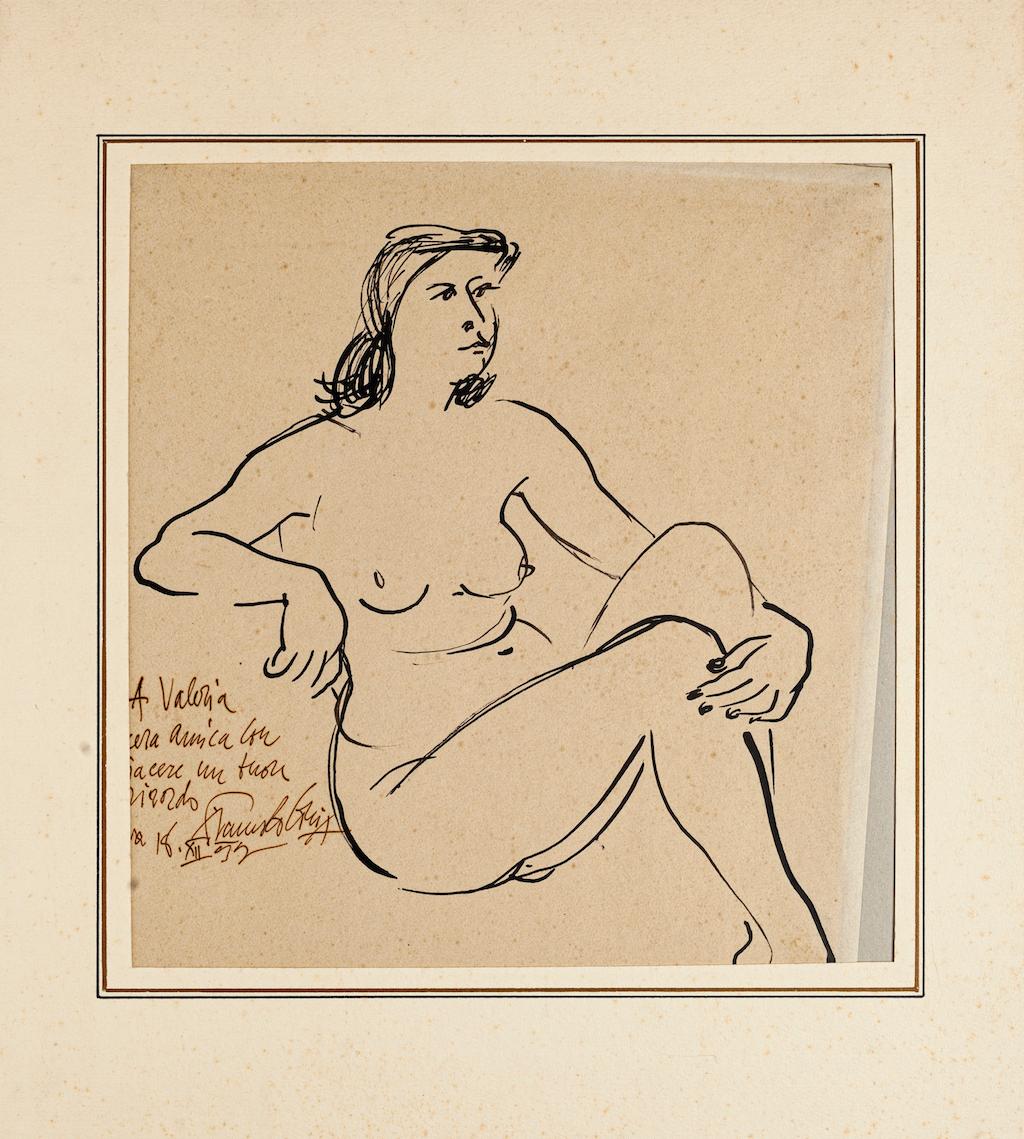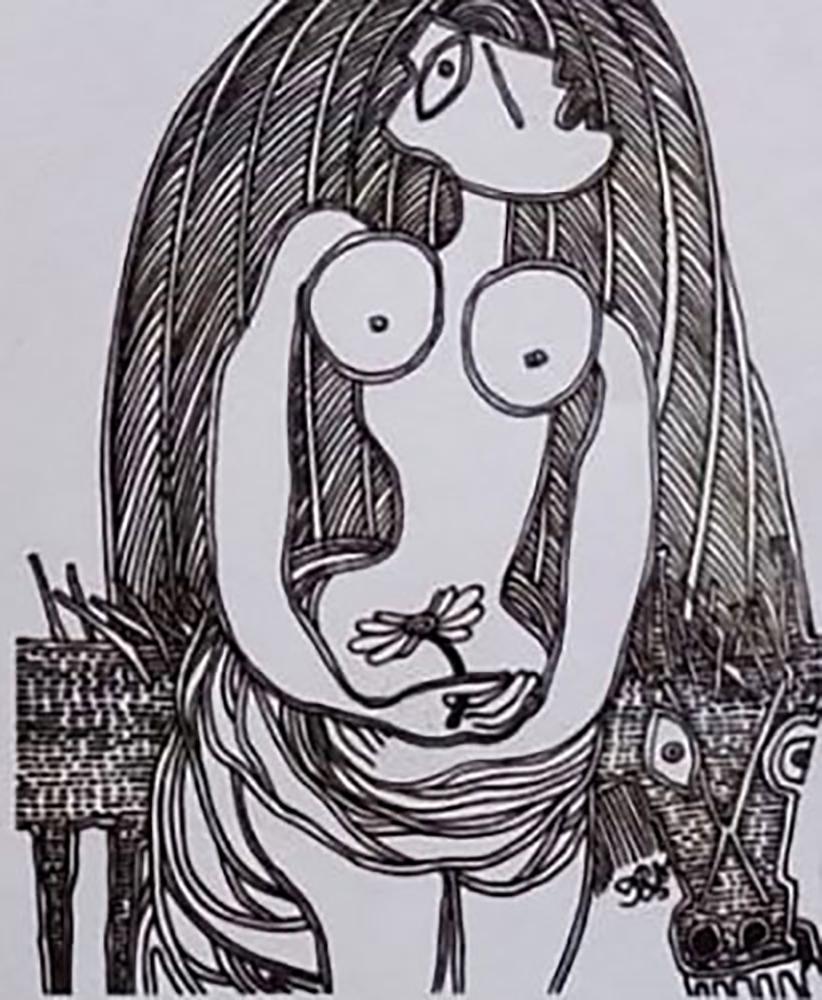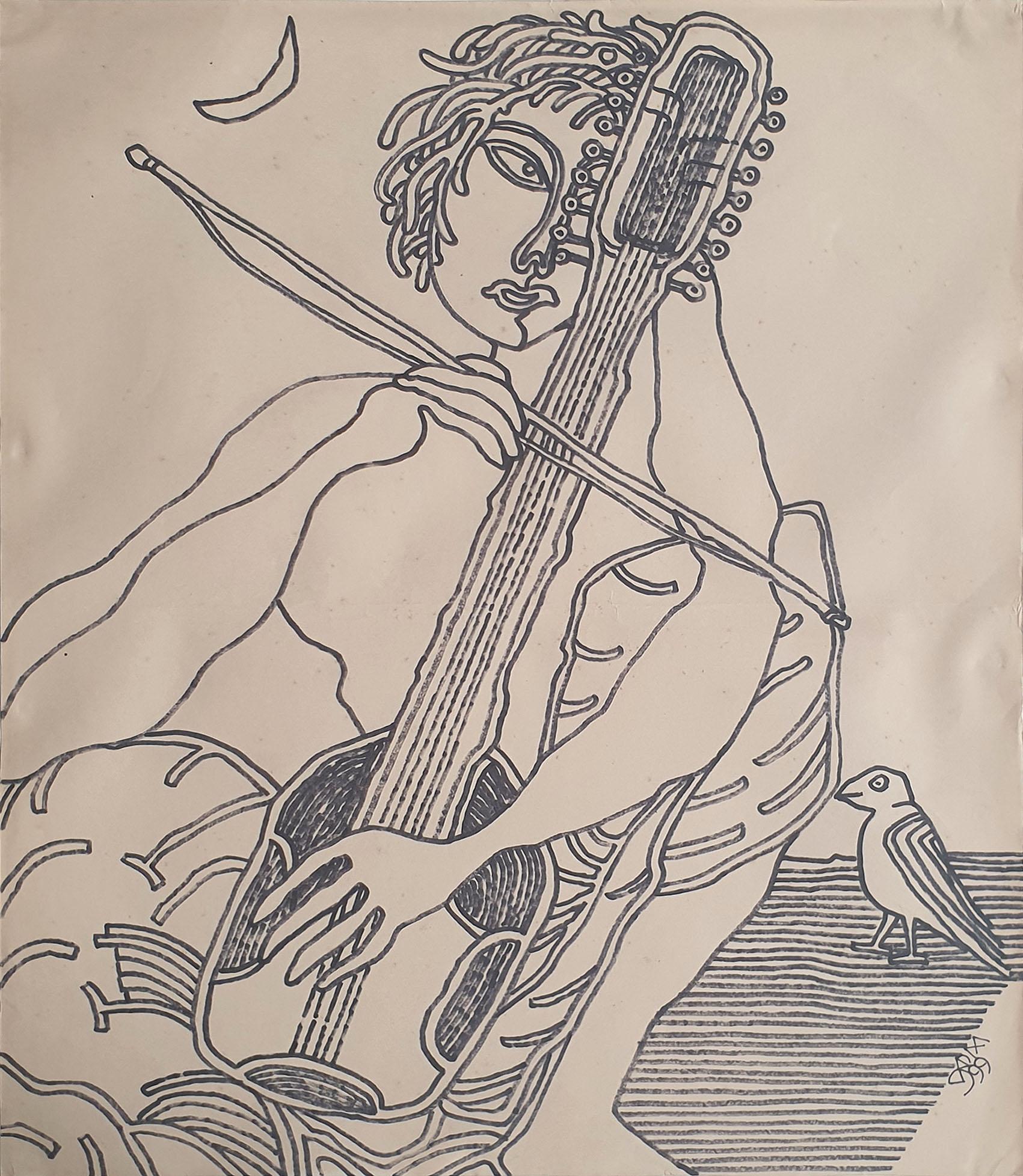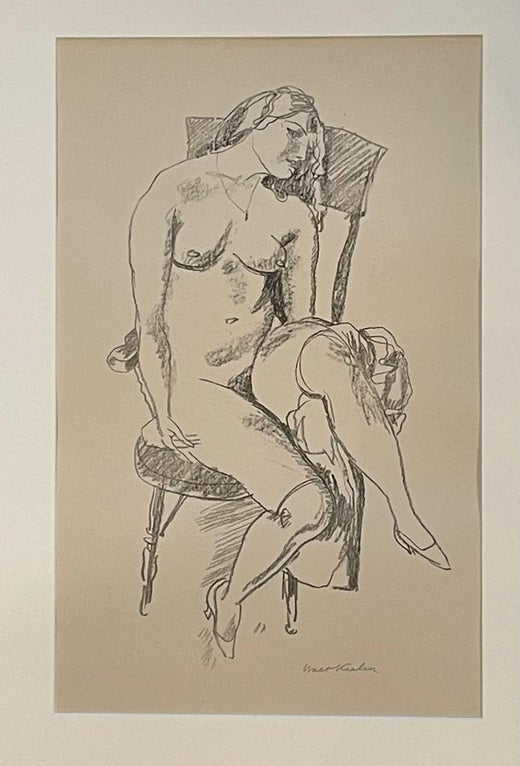Items Similar to "Reclining Figure" Walt Kuhn, Figurative Nude Line Drawing, American Modernism
Want more images or videos?
Request additional images or videos from the seller
1 of 10
Walt Kuhn"Reclining Figure" Walt Kuhn, Figurative Nude Line Drawing, American Modernism1935
1935
About the Item
Walt Kuhn
Reclining Figure, 1935
Signed and dated lower left
Pen on paper
Sight 11 x 15 inches
Provenance:
Kennedy Galleries, New York
Spanierman Gallery, New York
Private Collection, New York
Exhibited:
New York, Kennedy Galleries, Walt Kuhn, December 3 - 31, 1968, no. 71.
Walter Kuhn was born on October 27, 1877 in Brooklyn, NY. His father, Francis Kuhn, was the owner of a ship provisioning business and several New York hotels. Kuhn’s mother, Amelia Hergehan, introduced her son to art and theater at a young age. From this point forward, Kuhn’s lifelong interest in art, theater and the circus began. For the remainder of his life, employment in the entertainment industry acted as a second career and source of income for the artist. More importantly, it provided limitless inspiration for his canvases.
At the age of 15, Kuhn sold his first drawings to a magazine and began to sign his name “Walt.” In 1893, he enrolled in evening art classes at the Brooklyn Polytechnic Institute. However, he soon lost interest in becoming an artist and instead, decided to open a bicycle shop in Brooklyn. In his lifetime, Kuhn would become known for his impulsive, yet dedicated personality.
By 1899, Kuhn had become enamored with ideas of the American West, and with only $60 in his pocket, he set out for California. Upon his arrival in San Francisco, he again took up the pen and became a cartoonist for WASP magazine. In 1901, the young artist departed for Paris, where he enrolled in formal art classes at the Academy Colarossi. Finding too little discipline for his liking in Paris, Kuhn soon left for the Royal Academy in Munich, where he studied under Barbizon painter Heinrich von Zugel (1850-1941).
In 1903, he returned to New York and immersed himself in the booming art scene. While continuing to work as an illustrator for local journals, he helped manage the Kit Kat Club- an organization that raised funds for scholarships at the National Academy of Design. In 1905, he held his first exhibition at the artist run, Salmagundi Club, establishing himself as both a cartoonist and a serious painter. That same year, he submitted his first illustrations to LIFEmagazine.
Kuhn regularly spent his summers in Fort Lee, NJ— one of the early homes of the movie industry. The area provided the maturing artist with the creative environment he needed to thrive. When the New York School of Art moved to the area in the summer of 1908, Kuhn joined the faculty. However, he soon came to dislike his experience as an instructor, and when the school moved back to New York, he also went along- only this time, in separate ways.Upon his return, he married Vera Spier. The couple had one child, a daughter Brenda Kuhn.
While his home life was beginning to blossom, so was his career. In 1909, he spent the year preparing his first one-man exhibition for the Madison Gallery in New York. The show proved to be a huge success. Soon after, Kuhn took part in establishing the Association of American Painters and Sculptors- the organization responsible for the landmark Armory Show of 1913. As the executive secretary, he was responsible for finding artists to participate. The Armory Show, which displayed both European and American modern art to New York audiences for the first time, proved to be a huge success de scandale. In 1938, Kuhn published an “insider’s” viewpoint to the event in his seminal essay, “The Story of the Armory Show.” Following the exhibition, Kuhn began to explore new ways for artists to break established barriers. In 1917, he founded the Penguin Club, an organization where artists held open meetings and provided criticism for each other.
By 1925, Kuhn’s health had taken a dramatic turn when a duodenal ulcer almost killed him. After a prolonged recovery, he eventually joined the faculty of the Art Student’s League. He also took up a commission for the Union Pacific Railroad, in which he completed designs for new club cars. Almost foreseeing the end of his career, the aging artist organized his first retrospective in 1939, which took the form of a book titled, Fifty Paintings by Walt Kuhn.
By the 1940s, Kuhn’s eccentric behavior began to take on unstable forms that had never surfaced before. He became increasingly distant, and when the Ringling Brothers, Barnum and Bailey Circus was in town, he religiously attended. This particular painting is similar to that of Milton Avery's circus paintings from the same period. In consequence, his unsound demeanor did not go unnoticed, and in 1948, he was institutionalized.
Kuhn’s last years are marked with tragedy and remain a mystery. Rumors of attempted suicides plague his biographies. Nonetheless, on July 13, 1949, he died instantly from a perforated ulcer. In a bittersweet act, Vera and Brenda Kuhn placed his favorite drawing pen in his jacket pocket prior to his wake.
Walt Kuhn
Walt Kuhn (1877-1949) He was associated with "The Eight" and with Arthur B. Davies, was a the key figure in forming the American Association of painters and Sculptors that organized the Armory Show of 1913 that introduced modernist European art to America. Kuhn was executive secretary of the Association and traveled abroad to select entries for the Armory Show. He was strongly influenced by Cezanne which is evident in many of his paintings. Like Cezanne, he destroyed many of his paintings, keeping only about a dozen a year. He was born in Brooklyn, New York and in 1900 first used the name Walt when illustrating magazines in San Francisco. He studied at the Royal Academy in Munich from 1901 to 1903 and returned to New York where he worked as a cartoonist and magazine illustrator. In the permanent collection of most major museums worldwide. His record price for a painting to date is 1.6 Million dollars.
About the Seller
5.0
Platinum Seller
These expertly vetted sellers are 1stDibs' most experienced sellers and are rated highest by our customers.
Established in 2021
1stDibs seller since 2022
63 sales on 1stDibs
Typical response time: <1 hour
- ShippingRetrieving quote...Ships From: New York, NY
- Return PolicyA return for this item may be initiated within 3 days of delivery.
More From This SellerView All
- "In Foreign Parts" Eugene Higgins, Southwestern Pueblo, Modern FigurativeBy Eugene HigginsLocated in New York, NYEugene Higgins In Foreign Parts, circa 1913 Signed lower right Watercolor on paper Sight 17 x 13 inches Born William Victor Higgins in 1884 to a Shelbyville, Indiana farm family where the only art Victor was aware of as a child was his father's love of flowers. "He loved their forms and their colors, and he tended his garden as a painter might work a canvas." At the age of nine, Victor met a young artist who traveled the Indiana countryside painting advertisements on the sides of barns. He purchased paints and brushes so the young Higgins could practice his own artwork on the inside of his father's barn. He also taught Victor about art museums and especially about the new Chicago Art Institute. This information never left the young artist, and he saved his allowance until his father allowed him at the age of fifteen to attend Chicago Art Institute. He worked a variety of jobs to finance his studies both there and at the Academy of Fine Arts. Victor Higgins traveled to New York in 1908, where he met Robert Henri, who became a significant influence by depicting every-day scenes and stressing the importance of the spirit and sense of place as important factors in painting. Higgins was also greatly affected by the New York Armory Modernism Show of Marsden Hartley in 1913. While Victor Higgins was in Chicago he met former mayor and avid collector Carter H. Harrison who was to prove instrumental in the growth of Higgins career for several years. Harrison agreed to support Higgins for four years to go to Paris and Munich and paint and study in the great museums in Europe. While at the Academie de la Grande Chaumier in Paris (1910-1914) he met Walter Ufer, who was another Chicago artist being sponsored by Carter Harrison. This meeting was not only a life-long friendship, but the beginning of a great change in the way Higgins looked at "American" art. He decided that America needed it's own authentic style rather than the 19th Century classic style he was taught in Europe. Very soon after returning to Chicago in 1914, Harrison sent him and Walter Ufer on a painting trip to Taos, New Mexico for a year in exchange for paintings. Higgins made other similar agreements and was able to support himself with his painting. This trip was a life-changing experience and introduced Higgins to the authentic America he had been looking for. In 1914 Taos was an isolated village about twelve hours from Santa Fe on an impossible dirt road. But the colorful life of the pueblo people and the natural beauty drew a collection of artists who became the Taos art colony, from which the Taos Society of Artists was founded in 1915. Victor Higgins became a permanent resident within a year of his arrival and a member of the society in 1917, exhibiting with Jane Peterson in 1925 and with Wayman Adams and Janet Scudder in 1927. The members would travel around the country introducing the Southwest scenes with great success. He remained a member until the Society's dissolution in 1927. Higgins was the youngest member of the group of seven. Other members were Joseph Henry Sharp, Bert Phillips...Category
1910s American Modern Figurative Drawings and Watercolors
MaterialsWatercolor, Paper
- "Untitled" Bob Thompson, Figurative Work on Paper, Black Abstract ArtistBy Bob ThompsonLocated in New York, NYBob Thompson Untitled, 1964 Felt tip pen on printed paper 11 x 20 1/2 inches Provenance: The artist Kathy Komaroff Goodman (gift from the artist) Hollis Taggart, New York Exhibited...Category
1960s Modern Figurative Drawings and Watercolors
MaterialsWatercolor, Paper
- "March Avery in Beret, " Milton Avery, American Modernism, Portrait of ArtistBy Milton AveryLocated in New York, NYMilton Clark Avery (1885 - 1965) March Avery in a Beret, 1951 Black crayon and graphite on cream wove paper 11 x 8 3/8 inches Signed and dated lower left; ...Category
1950s American Modern Portrait Drawings and Watercolors
MaterialsGraphite, Crayon, Paper, Pencil
- "Young Girl (Jenue Fille)" Louis Valtat, French DrawingBy Louis ValtatLocated in New York, NYLouis Valtat Young Girl Stamped with initials lower right Pencil on brown paper Sight 7 x 6 inches Provenance: Mrs. Ernest M. Werner, New York Private Collection, Rhode Island Loui...Category
Early 20th Century Fauvist Figurative Drawings and Watercolors
MaterialsPaper, Pencil
- "Night Stroll" Amy Londoner, Ashcan School, Figurative NocturneBy Amy LondonerLocated in New York, NYAmy Londoner Beach at Atlantic City, circa 1922 Signed lower right Pastel on paper Sight 23 x 18 inches Amy Londoner (April 12, 1875 – 1951) was an American painter who exhibited at...Category
1910s Ashcan School Figurative Paintings
MaterialsPastel, Paper
- "Figure Study" Rockwell Kent, American Modernism, Work on PaperBy Rockwell KentLocated in New York, NYRockwell Kent Figure Study Estate stamped lower right Ink on paper 6 x 10 inches Rockwell Kent, though best known as an artist and illustrator, pursued many careers throughout his long life, including architect, carpenter, explorer, writer, dairy farmer, and political activist. Born in Tarrytown, New York, Kent was interested in art from a young age. These ambitions were encouraged by his aunt Jo Holgate, an accomplished ceramicist. Jo came to live with the family after Kent’s father passed away in 1887 and took him to Europe as a teenager. Kent attended the Horace Mann School in New York City, where he excelled at mechanical drawing. His family’s financial circumstances prevented him from pursuing career in the fine arts, however, and after graduating from Horace Mann in 1900, Kent decided to study architecture at Columbia University. Before matriculating at Columbia, Kent spent the first of three consecutive summers studying painting at William Merritt Chase’s art school in Shinnecock Hills, Long Island. There he found a community of mentors and fellow students who encouraged him to pursue his interest in art. At the end of Kent’s third summer at Shinnecock, Chase offered him a full scholarship to the New York School of Art, where he was a teacher. Kent began taking night classes at the art school in addition to his architecture studies, but soon left Columbia to study painting full time. In addition to Chase, Kent took classes with Robert Henri (American, 1865 - 1929) and Kenneth Hayes Miller (American, 1876 - 1952). His classmates included the artists George Bellows (American, 1882 - 1925) and Edward Hopper (American, 1882 - 1967). Kent spent the summer of 1903 assisting the painter Abbott Handerson Thayer (American, 1849 - 1921) at his studio in Dublin, New Hampshire—a position he secured through the recommendation of his Aunt Jo. Thayer gave the young artist time to pursue his own work, and that summer Kent painted several views of the New Hampshire landscape, including Mount Monadnock. In 1905 Kent moved from New York to Monhegan Island in Maine, home to a summer art colony, where he continued to find inspiration in the natural world. Kent soon found success exhibiting and selling his paintings in New York and in 1907 was given his first solo show at Claussen Galleries. The following year he married his first wife, Kathleen Whiting (Thayer’s niece), with whom he had five children. The couple divorced in 1924, and Kent married Frances Lee the following year. They in turn divorced after 15 years of marriage, and the artist then married Sally Johnstone. For the next several decades, Kent lived a peripatetic lifestyle, settling in several locations in Connecticut, Maine, and New York. During this time he took a number of extended voyages to remote, often ice-filled, corners of the globe, including Newfoundland, Alaska, Tierra del Fuego, and Greenland, to which he made three separate trips. For Kent, exploration and artistic production were twinned endeavors, and his travels to these rugged, rural locales provided inspiration for both his visual art and his writings. He developed a stark, realist landscape style in his paintings and drawings that revealed both nature’s harshness and its sublimity. Kent’s human figures, which appear sparingly in his work, often signify mythic themes, such as heroism, loneliness, and individualism. Important exhibitions of works from these travels include the Knoedler Gallery’s shows in 1919 and 1920, featuring Kent’s Alaska drawings...Category
Early 20th Century Figurative Drawings and Watercolors
MaterialsPaper, Ink
You May Also Like
- Nude - Pen on Ivory Paper by Fausto Ghia - 1955Located in Roma, ITNude is an original drawing in pen on ivory paper realized by Fausto Ghia. Hand-signed on the lower left with dedication. The state of preservation is very good. Included a Passep...Category
1950s Modern Figurative Drawings and Watercolors
MaterialsPaper, Pen
- Rare Early Drawing I, Nude, Pen, Ink on paper by Master Artist "In Stock"By Sunil DasLocated in Kolkata, West BengalSunil Das - Rare Early Drawing I 22 x 8.25 inches (unframed size) Pen & Ink on paper Complimentary shipment in a roll form. Sunil Das ( 1939-2015) was a Master Modern Indian Arti...Category
1980s Modern Figurative Drawings and Watercolors
MaterialsInk, Pen, Paper
- Woman seated in Garden, Nude, Ink on paper by Modern Indian Artist "In Stock"By Prakash KarmarkarLocated in Kolkata, West BengalPrakash Karmakar - Untitled - 23 x 20 inches Marker on Paper , 2002 Delivery of shipment in roll form. Style : Legendary master artist Lt. Prokash Karmakar from Bengal was solely re...Category
Early 2000s Modern Figurative Drawings and Watercolors
MaterialsInk, Permanent Marker, Paper
- Woman with Flower, Nude, Marker on paper by Modern Indian Artist "In Stock"By Prakash KarmarkarLocated in Kolkata, West BengalPrakash Karmakar - Untitled - 23 x 20 inches (unframed size) Marker on paper Delivery of shipment in roll form. Style : Legendary master artist Lt. Prokash Karmakar from Bengal was ...Category
Early 2000s Modern Figurative Drawings and Watercolors
MaterialsInk, Permanent Marker, Paper
- Woman playing Sitar, Nude, Ink on paper by Modern Indian Artist "In Stock"By Prakash KarmarkarLocated in Kolkata, West BengalPrakash Karmakar - Untitled - 23 x 20 inches Marker on Paper , 1999 Delivery of shipment in roll form. Style : Legendary master artist Lt. Prokash Karmakar from Bengal was solely re...Category
Early 2000s Modern Figurative Drawings and Watercolors
MaterialsInk, Permanent Marker, Paper
- Nude Woman, Drawing, Ink, Marker on Paper by Modern Indian Artist"In Stock"By Prakash KarmarkarLocated in Kolkata, West BengalPrakash Karmakar - Untitled - 23 X 20 inches (unframed size) Marker on Paper Delivery of shipment in ready to hang condition. Style : Legendary master artist Lt. Prokash Karmakar fr...Category
1990s Modern Figurative Drawings and Watercolors
MaterialsPermanent Marker, Ink, Paper
Recently Viewed
View AllMore Ways To Browse
Line Drawing
Line Drawings
Line Drawing Art
Line Drawing Painting
Line Figure
Drawings Brooklyn
Line Drawing Framed
Modernism Paintings
Figure Line Art
Early American Figure
American Modernism
Ship Of The Line
Vintage Drawing Ideas
Nude Line
Modernism Gallery
Line Drawing Figure
Early European Modernism
1940s Modernism





